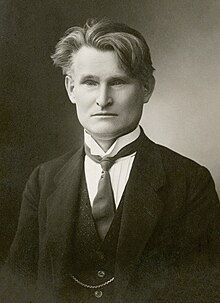Our website is made possible by displaying online advertisements to our visitors.
Please consider supporting us by disabling your ad blocker.
Kazys Grinius
Kazys Grinius | |
|---|---|
 Grinius in 1926 | |
| 3rd President of Lithuania | |
| In office 7 June 1926 – 17 December 1926 | |
| Preceded by | Aleksandras Stulginskis |
| Succeeded by | Jonas Staugaitis (acting) |
| 6th Prime Minister of Lithuania | |
| In office 19 June 1920 – 18 January 1922 | |
| President | Aleksandras Stulginskis |
| Preceded by | Ernestas Galvanauskas |
| Succeeded by | Ernestas Galvanauskas |
| Personal details | |
| Born | 17 December 1866 Selema, Augustów Governorate, Russian Empire |
| Died | 4 June 1950 (aged 83) Chicago, Illinois, U.S. |
| Political party | Lithuanian Popular Peasants' Union |
| Spouse(s) | Joana Pavalkytė-Griniuvienė Kristina Arsaitė-Grinienė |
| Children | Liūtas Grinius (died 1989) |
| Alma mater | Imperial Moscow University (1893) |
| Signature | |
| Righteous Among the Nations |
|---|
 |
| By country |
Kazys Grinius ([kɐˈzʲiːs ˈɡʲrʲɪnʲʊs] ⓘ, 17 December 1866 – 4 June 1950) was the third President of Lithuania, holding the office from 7 June 1926 to 17 December 1926.[1][2] Previously, he had served as the fifth Prime Minister of Lithuania, from 19 June 1920 until his resignation on 18 January 1922. He was posthumously awarded the Lithuanian Life Saving Cross for saving people during the Holocaust and was recognised as a Righteous Among the Nations in 2016.[3]
Grinius was born in Selema, near Marijampolė, in the Augustów Governorate of Congress Poland, which was part of the Russian Empire. He studied medicine at the Imperial Moscow University and became a physician. As a young man, he became involved in Lithuanian political activities, and was persecuted by the Tsarist authorities. In 1896, he was one of the founders of the Lithuanian Democratic Party (LDP) and Lithuanian Popular Peasants' Union (LVLS) party. That same year he married Joana Pavalkytė. For some time they lived in Virbalis. In 1899, their son Kazys (later head of the Lithuanian National Council)[4] was born, and in 1902, their daughter Gražina was born. During World War I they lived in Kislovodsk. In 1918, during a Red Army attack, his wife and daughter were murdered by Russian terrorists.[2] They were buried in Kislovodsk cemetery.
When Lithuania regained its independence in 1918, Grinius became a member of the Constituent Assembly as a member of the Lithuanian Popular Peasants' Union party. He served as prime minister from 1920 until 1922,[1][2] and signed a treaty with the Soviet Union. He was elected president by the Third Seimas, but served for only six months, as he was deposed in a coup led by Antanas Smetona on the pretext of an imminent communist plot to take over Lithuania.[2] Grinius then practiced medicine in Kaunas.[2] When Nazi Germany invaded Lithuania in 1941, Grinius refused to collaborate with the Germans because of his opposition to the occupation of Lithuania by any foreign power. He fled to the West when the Soviet army reoccupied Lithuania in 1944, and he emigrated to the United States in 1947.[1][5]
He died in Chicago in 1950.[1][2][5] After Lithuania regained its independence in 1990, his remains were returned and buried near his home village.
- ^ a b c d "Dr. Kazys Grinius Dies; Ex-President of Lithuania". Evening Star. Washington, DC. 5 June 1950. p. 12. Retrieved 29 June 2023 – via Newspapers.com.

- ^ a b c d e f "Grinius, Former Lith President, Dies Here at 83". Chicago Tribune. Chicago, IL. 5 June 1950. p. 59. Retrieved 30 June 2023 – via Newspapers.com.

- ^ "Apdovanoti pasaulio tautų teisuoliai". www.jmuseum.lt (in Lithuanian). 21 October 2016. Retrieved 4 January 2023.
- ^ "Col. Grinius Haed of Lithuanian National Council". The Lithuanian American Week. Chicago, IL. 10 April 1942. pp. 1, 2. Retrieved 1 July 2023 – via Newspapers.com.

- ^ a b Cite error: The named reference
britwas invoked but never defined (see the help page).
Previous Page Next Page


